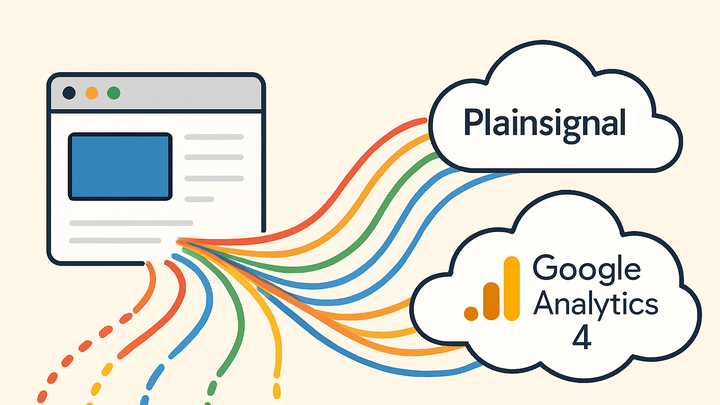Published on 2025-06-26T05:27:18Z
What is a Data Stream? Examples with PlainSignal and GA4
A data stream is a continuous flow of event data generated by user interactions, system logs, or devices, and delivered in real time or near real time to analytics platforms for processing and analysis. In web analytics, data streams enable immediate insights into user behavior, performance metrics, and system health. Tools like PlainSignal (a cookie-free, lightweight analytics solution) and Google Analytics 4 leverage data streams to ingest events with minimal latency and high scalability. By using data streams, organizations can monitor and react to changes in traffic patterns, optimize user experiences, and detect anomalies as they occur.
Data stream
Continuous flow of user interaction events from websites or apps into analytics platforms for real-time analysis.
Core Concepts of Data Streams
Explore the fundamental attributes that define a data stream in analytics.
-
Definition
A data stream is a continuous, ordered sequence of data points or events generated by user interactions, system logs, or sensors.
-
Characteristics
Key properties that differentiate streams from batch data.
-
Velocity
High-speed generation and delivery of events in real time.
-
Volume
Potentially unbounded data size requiring scalable processing.
-
Variety
Diverse event types like pageviews, clicks, and transactions.
-
Data Stream in Web Analytics
How data streams are applied within web analytics to track user behavior and events.
-
Client-side event streams
Events sent directly from the user’s browser using JavaScript libraries, as seen in PlainSignal and GA4.
-
Server-side event streams
Backend-driven streams that send events from servers or cloud functions, improving data consistency and privacy.
Implementing Data Streams with SaaS Tools
Step-by-step integration of data streams using popular analytics platforms.
-
PlainSignal (cookie-free analytics)
Integrate a lightweight, privacy-focused data stream:
<link rel="preconnect" href="//eu.plainsignal.com/" crossorigin /> <script defer data-do="yourwebsitedomain.com" data-id="0GQV1xmtzQQ" data-api="//eu.plainsignal.com" src="//cdn.plainsignal.com/plainsignal-min.js"></script> -
Google analytics 4
Set up a GA4 data stream via the Google Analytics interface or using gtag.js:
<script async src="https://www.googletagmanager.com/gtag/js?id=G-XXXXXXX"></script> <script> window.dataLayer = window.dataLayer || []; function gtag(){dataLayer.push(arguments);} gtag('js', new Date()); gtag('config', 'G-XXXXXXX'); </script>
Use Cases and Benefits
Discover practical scenarios where data streams provide value in analytics.
-
Real-time monitoring
Instant visibility into traffic spikes, campaign performance, and system health.
-
User behavior analysis
Detailed tracking of click paths, session durations, and conversion funnels.
-
Anomaly detection
Early warning of irregular patterns, such as sudden drops in engagement.
Best Practices for Managing Data Streams
Guidelines to ensure reliable, efficient, and compliant data streaming.
-
Data governance
Implement clear schemas, event naming conventions, and privacy controls.
-
Latency optimization
Minimize processing delays with efficient buffering and scalable infrastructure.
-
Error handling
Design retry mechanisms and logging to capture failed events gracefully.
